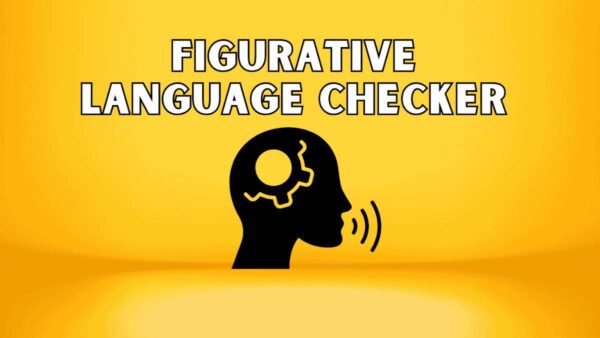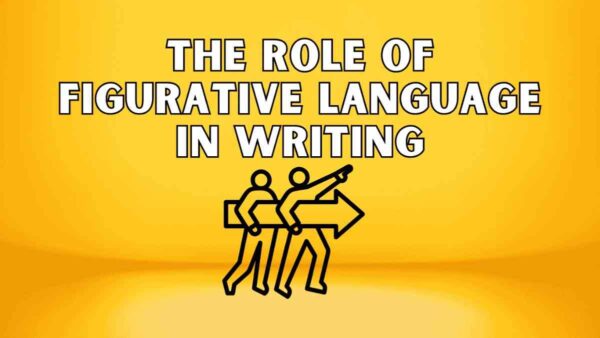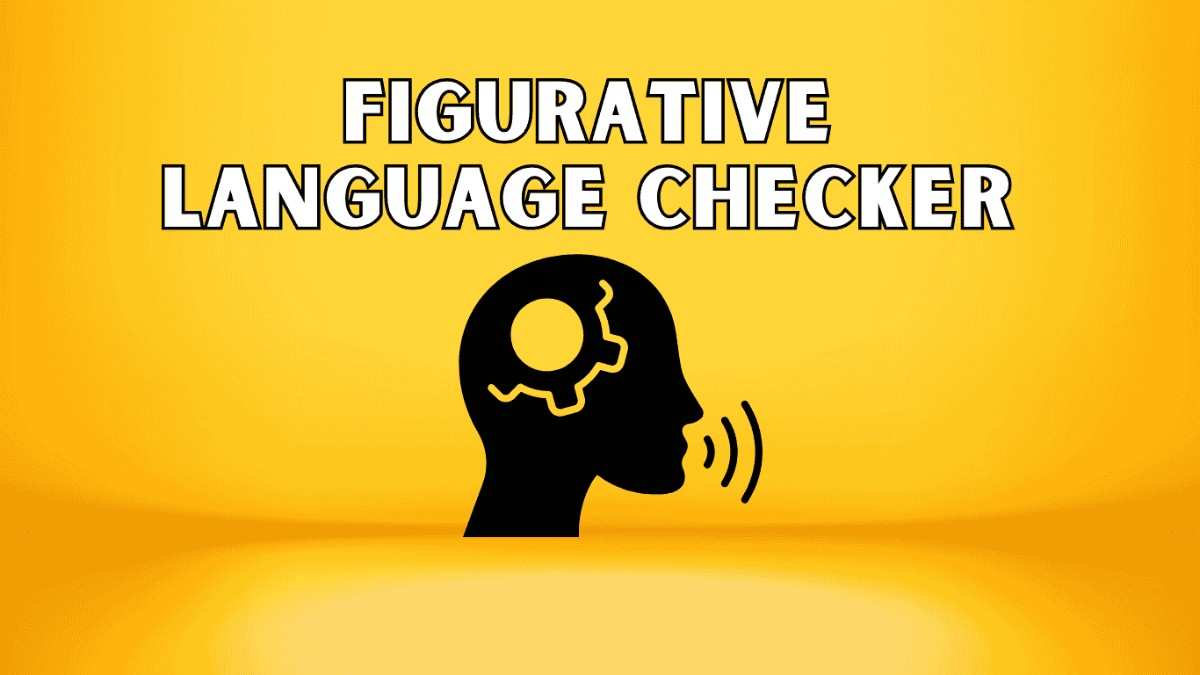Introduction
A figurative language checker is an AI-powered tool that analyses your writing to find and refine different forms of figurative language. In this comprehensive guide, we’ll cover the essential information you need about figurative language. And the reasons you require a figurative language checker. How it functions and the best ways to incorporate figurative languages into your writing. When you’re done with this article, you’ll understand how a figurative language checker can enhance your content. And make it more exciting and help you avoid common errors. Let’s get started!
Figurative Language Checker
What Is a figurative language checker?
A figurative language checker helps writers spot and analyze literary devices in their text. It detects similes, hyperboles, personification, metaphors, and idioms. Each device adds layers of meaning and emotion. The tool scans your writing, flags figurative phrases, and offers suggestions to improve clarity and impact.

How It Works
It can identify important phrases through comparing your texts to the patterns that are known to be prevalent. For instance, it could identify phrases such as “as smooth as silk” (a simile) or “time is a thief” (a metaphor).
The tool then classifies each figurative word as a personification, simile hyperbole, metaphor, or idiom.
Based on an analysis It suggests alternative expressions. It identifies instances where the figurative language is used too often or is cliched.
Then, you get complete reports with highlighted phrases, suggestions for categorizing and insight into the quality and clarity of your usage of figurative language.
The Role of Figurative Language in Writing

Figurative language is the foundation of effective and creative writing. It transforms abstract concepts into tangible images. It creates feelings that are resonant with readers. Let’s examine the various types of figurative writing and how they help to improve the art of writing.
Similes
Similes are used to make comparisons using words such as “like” or “as.” They can help create vivid images by connecting seemingly unrelated ideas or objects.
Examples:
- Her smile was as radiant as the sun.
- He was a lion fighting the war.
Utilizing the an figurative language checking tool makes sure that your similes remain unique and effective, guiding away from clichés.
Metaphors
In contrast to similes, metaphors make direct comparisons without the use of “like” or “as.” They suggest that one thing is similar to another and can provide layers of meaning to your text.
Examples:
- The time is a stealer who steals our precious moments.
- Her words were like a sharp knife cutting through the silence.
A figurative language checking tool helps to ensure that the metaphors you use are clear and powerful.
Personification
Personification relates human qualities to non-human objects or abstract concepts making descriptions more relevant and vivid.
Examples:
- The wind blew through the trees.
- The moon smiled at us.
By using this tool, you can tweak your language to trigger the desired emotion of your viewers.
Hyperbole
Hyperbole makes use of exaggeration in order to create an emphasis or a sense of humor. It’s a useful tool when used with care however excessive use can decrease its impact.
Examples:
- I’ve told you that a million times!
- The student has a mountain of work to do!
A figurative language checker will aid in maintaining the balance. And making sure that hyperboles create the desired effect, but not overwhelm your text.
Idioms
Idioms are words which have no meaning that can be deduced from the literal meanings. They provide a cultural and emotional flavour to writing.
Examples:
- It’s raining cats as well as dogs.
- He threw the bucket.
A figurative language checking tool assists in using idioms correctly and ensures. And ,they resonate with your intended readers and match into the overall context of your writing.
Benefits of Using a figurative language checker
Enhancing Creativity and Engagement
Utilizing a figurative language checker allows writers to be more creative. By analysing your text, the program gives you insight into how your language figurative is performing. This allows you to experiment with new words and phrasings, and then refine your style, resulting in more memorable and engaging writing.
Avoiding Cliches and Redundancy
One of the most common mistakes in writing is using cliches too often. The use of phrases like “cold as ice” or “as old as time” can stifle the authenticity of your writing. A figurative language tester will identify these cliches, and allows the user to substitute them with new creative and imaginative comparisons that better express your distinctive voice.
Improving Clarity and Impact
Effective figurative language will enhance clarity and depth to your content. With a figurative language checker, you can be sure that every simile, metaphor, and hyperbole adds value to your message, rather than making your readers confused. This will make your content more effective and easy to comprehend.
Assisting in Academic and Professional Writing
In professional and academic situations, precision is crucial. A figurative checker can assist professionals and students. It can assist with the editing of their essays, reports and presentations by making sure that the appropriate use of figurative words is made. This improves not only the quality of writing, but also shows an increased degree of critical thinking and the ability to communicate.
Supporting ESL and Non-Native Speakers
For non-native English speakers understanding the subtleties of figurative language can be a challenge. A checker for figurative language provides useful feedback that can help ESL writers to understand the meaning of idiomatic words and metaphors better. This results in more precise, efficient communications in English.
Best Practices to Integrate the figurative language checker to your workflow
1. Regular Use for Draft Review
Integrate the checker for figurative language into your writing routine. Before completing any piece, run the text through the checker in order to find and correct any sloppy or unclear figurative language.
2. Balancing Literal and Figurative Language
While figurative language adds some color to your writing however, it should be used with care. Find a balance of both figurative and literal expressions to ensure the clarity. In addition, a text that is cluttered with too many literary devices could cause readers to become overwhelmed and dilute your message.
3. Experiment and Revise
Make use of the tool to help you learn. Explore different types of figurative writing, and then revise the writing based on the feedback received. This process of iteration will help you create an original and memorable style of writing over time.
4. Context Is Key
Be sure that the metaphors you employ are appropriate to the tone and intent that you are writing. For instance, while hyperboles could be appropriate for blogs, they might not be appropriate for the context of a formal report. Allow the figurative-language checking tool guide you in ensuring consistency throughout your work.
5. Keep Your Audience in Mind
Always consider your target audience. What could be appealing to young readers may be too formal for a formal paper. You should tailor your usage of figurative language to meet your reader’s expectations and tastes.
The Impact of Figurative Language in Various Writing Contexts
Academic Writing
In academic research papers and essays In academic essays and research papers, figurative language is frequently used to convey complex ideas in terms that are understandable. When used appropriately it can make theoretic concepts more accessible and enthralling. However, excessive use can affect the tone of scholarly writing. A figurative language checking tool helps keep the right balance, making sure that the academic content you write is clear and vivid.
Creative Writing
For novelists, poets and storytellers the use of figurative language is a crucial tool. It creates a rich, immersive world and vivid imagery that draws readers into the story. Utilizing a checker for figurative languages in your writing can help you refine your stylistic choices, making sure that your similes and metaphors are original and memorable instead of being repetitive.
Business and Marketing Content
In the field of business writing clear communication is crucial. However, a little an evocative tone will make your presentations, pitch decks as well as marketing documents more convincing and interesting. A checker for figurative language can assist in making your language more precise so that your creative words enhance rather than detract from your primary messages.
Digital Content and SEO
Content on the internet must be captivating to readers quickly, while also performing effectively on search engines. Incorporating figurative language into your blog articles and posts can increase engagement, decrease bounce rates and boost your SEO rank. By using a figurative-language checking tool, you’ll be able to make sure that your blog content is optimised for users and search engines without losing clarity or originality.
Advanced Features and Future Developments in Figurative Language Checkers
AI-Driven Insights
Modern checkers for figurative languages make use of artificial intelligence in order to offer more than simple error detection. They provide insight into the tone, readability and the impact on your emotions of your written language. Future developments could include personalized suggestions depending on your writing style and the genre you are writing in.
Integration with Writing Platforms
Imagine a world in which your blogging or word processor includes a built-in figurative checker. This seamless integration could allow writers to receive instant feedback while they write which would make the revision process more efficient and easy. Some advanced checkers are making progress in this direction and have plugins available for the most popular writing software as well as Content management systems.
Enhanced User Interface and Reporting
The next generation of figurative language checking tools will likely have more interactive interfaces, including visually-based reports, thorough breakdowns and even comparative analysis. The tools won’t just provide areas for improvement, but also keep track of your improvement over time, helping you improve as an author.
Customizable Settings
Each piece of writing needs the same level of analysis of the figurative language. Future tools may allow you to modify the level of scrutiny by focusing on specific devices and omit other devices. This flexibility will ensure that the checker is able to meet your particular needs regardless of whether you’re writing blog post or an academic paper.
Case Studies: Real-World Applications of a Figurative Language Checker
Improving a College Essay
Take a look at a student who is writing an essay on contemporary literature. The draft is rich with figurative language, however certain metaphors and similes are excessively complicated and impede the simplicity of the argument. When the essay is run through a checker for figurative language students can spot clichés and awkward phrases. After editing the essay, it not only reads more fluently, however it retains its unique style, which results in an increase in score as well as positive feedback from the instructor.
Enhancing a Marketing Campaign
The marketing department is working on text for a brand new launch of a product. The draft includes innovative language that seeks to create excitement and sparks of innovation. But, some of the hyperbolic words appear forced, and certain metaphors seem as dated. With the aid of an illiterative language checker, the team can refine the language to ensure that the message resonates with the intended audience and has a fresh, engaging tone. The final version will result in higher engagement and higher conversion rates.
Elevating a Novel’s Prose
An author is in the process of revising his manuscript, and is looking to make sure that the figurative language is used to enhance rather than obstructs the narrative. The checker for figurative language highlights some passages in which metaphors seem too strong and suggests alternative phrases. By careful editing these sections the author can create an appropriate tone that draws readers and enhances the emotional resonance of the tale.
Common Pitfalls in Using Figurative Language and How to Avoid Them
Overuse of Figurative Expressions
The most frequent errors is relying too much on metaphors and figurative language. While these devices can enhance the text, using too many could overpower readers and obscure the message. A figurative language checking tool helps you stay on track by highlighting repeated or excessive use of figurative words.
Cliched and Stale Language
Many writers fall victim to using clichés that are no longer original. A figurative language checking tool can spot these phrases that are used frequently and encourages you to think of newer and more original alternatives. This method does more than improve your writing, but also increases your creativity.
Conclusion
The concept of figurative language forms the foundation for writing expressively. It transforms everyday texts into an artifact that displays vivid images and emotions. The checker for symbolic languages isn’t just a tool but a crucial tool for any writer who wants to enhance their writing. By analyzing, detecting and improving literary methods this tool lets you write in a manner that is both clear and imaginative.

